Employability Skills: Formal Business Meetings and Professionalism
VerifiedAdded on 2023/01/05
|12
|3056
|46
Report
AI Summary
This report provides a comprehensive overview of formal business meetings, emphasizing their importance in organizational communication and decision-making. It defines formal meetings, outlining their characteristics, purposes, and various types, such as annual general meetings, information-sharing sessions, team-building activities, planning meetings, and performance review meetings. The report then delves into the significance of meeting minutes, detailing their purpose in recording key information, decisions, and action plans. Furthermore, it examines common barriers that hinder effective meetings, including a lack of clarity in the agenda, scheduling inconsistencies, overloaded meeting rooms, and the unavailability of members. For each barrier, the report suggests practical solutions, such as establishing clear agendas, utilizing scheduling software, leveraging technology for room management, and employing indoor navigation systems. The report concludes by highlighting the importance of overcoming these barriers to ensure productive and successful business meetings, ultimately contributing to improved organizational outcomes and enhanced employability skills.
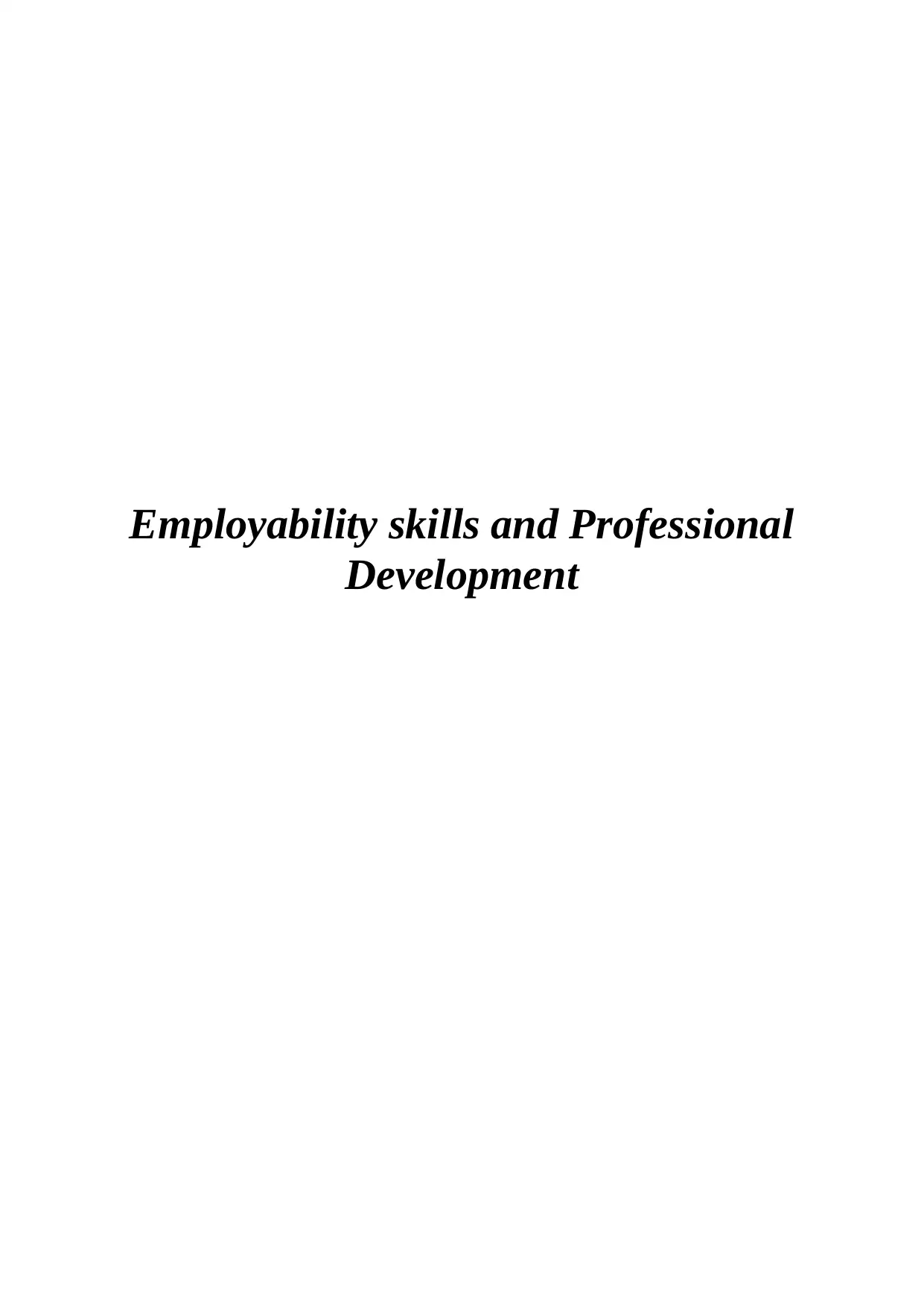
Employability skills and Professional
Development
Development
Paraphrase This Document
Need a fresh take? Get an instant paraphrase of this document with our AI Paraphraser
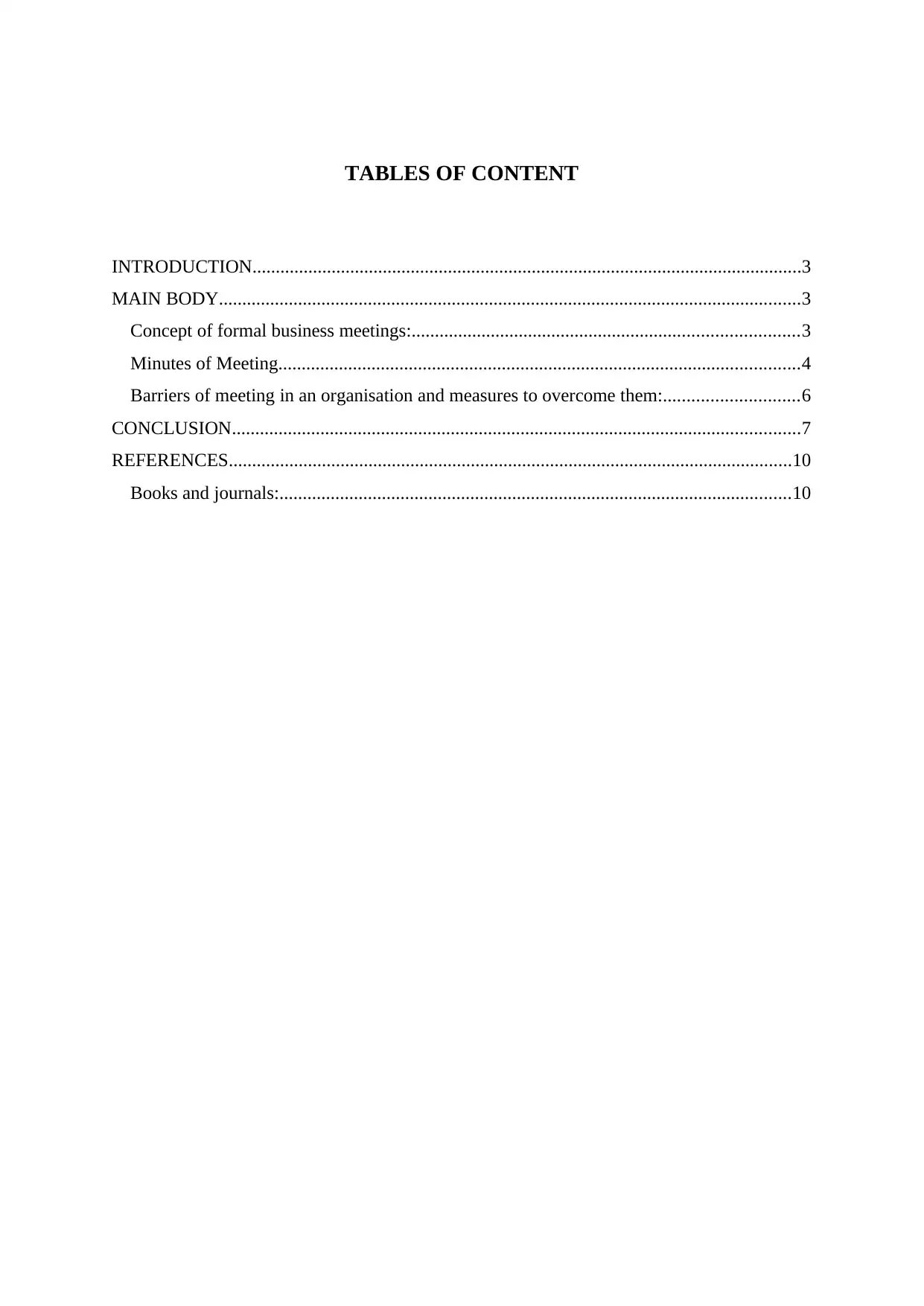
TABLES OF CONTENT
INTRODUCTION......................................................................................................................3
MAIN BODY.............................................................................................................................3
Concept of formal business meetings:...................................................................................3
Minutes of Meeting................................................................................................................4
Barriers of meeting in an organisation and measures to overcome them:.............................6
CONCLUSION..........................................................................................................................7
REFERENCES.........................................................................................................................10
Books and journals:..............................................................................................................10
INTRODUCTION......................................................................................................................3
MAIN BODY.............................................................................................................................3
Concept of formal business meetings:...................................................................................3
Minutes of Meeting................................................................................................................4
Barriers of meeting in an organisation and measures to overcome them:.............................6
CONCLUSION..........................................................................................................................7
REFERENCES.........................................................................................................................10
Books and journals:..............................................................................................................10
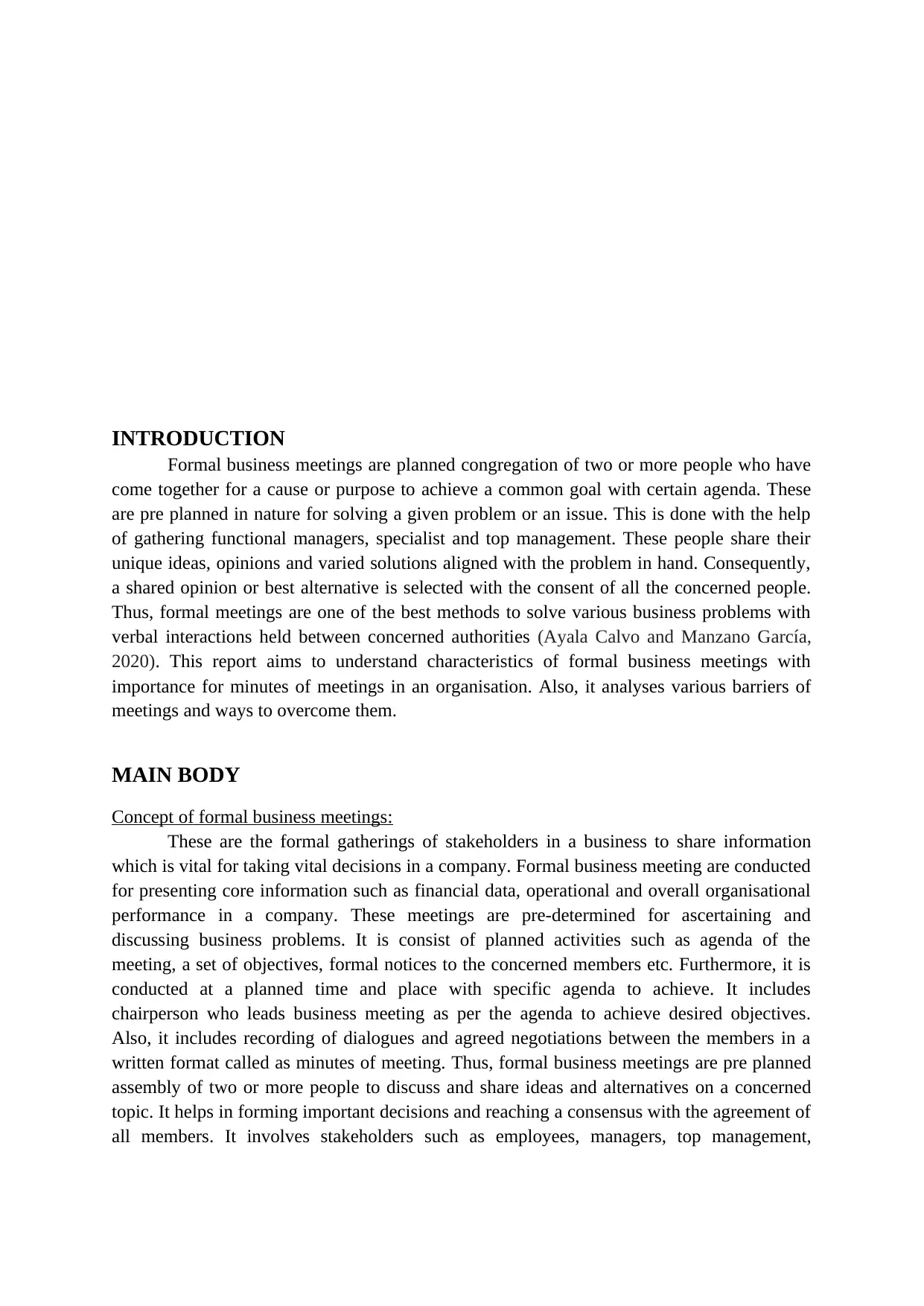
INTRODUCTION
Formal business meetings are planned congregation of two or more people who have
come together for a cause or purpose to achieve a common goal with certain agenda. These
are pre planned in nature for solving a given problem or an issue. This is done with the help
of gathering functional managers, specialist and top management. These people share their
unique ideas, opinions and varied solutions aligned with the problem in hand. Consequently,
a shared opinion or best alternative is selected with the consent of all the concerned people.
Thus, formal meetings are one of the best methods to solve various business problems with
verbal interactions held between concerned authorities (Ayala Calvo and Manzano García,
2020). This report aims to understand characteristics of formal business meetings with
importance for minutes of meetings in an organisation. Also, it analyses various barriers of
meetings and ways to overcome them.
MAIN BODY
Concept of formal business meetings:
These are the formal gatherings of stakeholders in a business to share information
which is vital for taking vital decisions in a company. Formal business meeting are conducted
for presenting core information such as financial data, operational and overall organisational
performance in a company. These meetings are pre-determined for ascertaining and
discussing business problems. It is consist of planned activities such as agenda of the
meeting, a set of objectives, formal notices to the concerned members etc. Furthermore, it is
conducted at a planned time and place with specific agenda to achieve. It includes
chairperson who leads business meeting as per the agenda to achieve desired objectives.
Also, it includes recording of dialogues and agreed negotiations between the members in a
written format called as minutes of meeting. Thus, formal business meetings are pre planned
assembly of two or more people to discuss and share ideas and alternatives on a concerned
topic. It helps in forming important decisions and reaching a consensus with the agreement of
all members. It involves stakeholders such as employees, managers, top management,
Formal business meetings are planned congregation of two or more people who have
come together for a cause or purpose to achieve a common goal with certain agenda. These
are pre planned in nature for solving a given problem or an issue. This is done with the help
of gathering functional managers, specialist and top management. These people share their
unique ideas, opinions and varied solutions aligned with the problem in hand. Consequently,
a shared opinion or best alternative is selected with the consent of all the concerned people.
Thus, formal meetings are one of the best methods to solve various business problems with
verbal interactions held between concerned authorities (Ayala Calvo and Manzano García,
2020). This report aims to understand characteristics of formal business meetings with
importance for minutes of meetings in an organisation. Also, it analyses various barriers of
meetings and ways to overcome them.
MAIN BODY
Concept of formal business meetings:
These are the formal gatherings of stakeholders in a business to share information
which is vital for taking vital decisions in a company. Formal business meeting are conducted
for presenting core information such as financial data, operational and overall organisational
performance in a company. These meetings are pre-determined for ascertaining and
discussing business problems. It is consist of planned activities such as agenda of the
meeting, a set of objectives, formal notices to the concerned members etc. Furthermore, it is
conducted at a planned time and place with specific agenda to achieve. It includes
chairperson who leads business meeting as per the agenda to achieve desired objectives.
Also, it includes recording of dialogues and agreed negotiations between the members in a
written format called as minutes of meeting. Thus, formal business meetings are pre planned
assembly of two or more people to discuss and share ideas and alternatives on a concerned
topic. It helps in forming important decisions and reaching a consensus with the agreement of
all members. It involves stakeholders such as employees, managers, top management,
⊘ This is a preview!⊘
Do you want full access?
Subscribe today to unlock all pages.

Trusted by 1+ million students worldwide
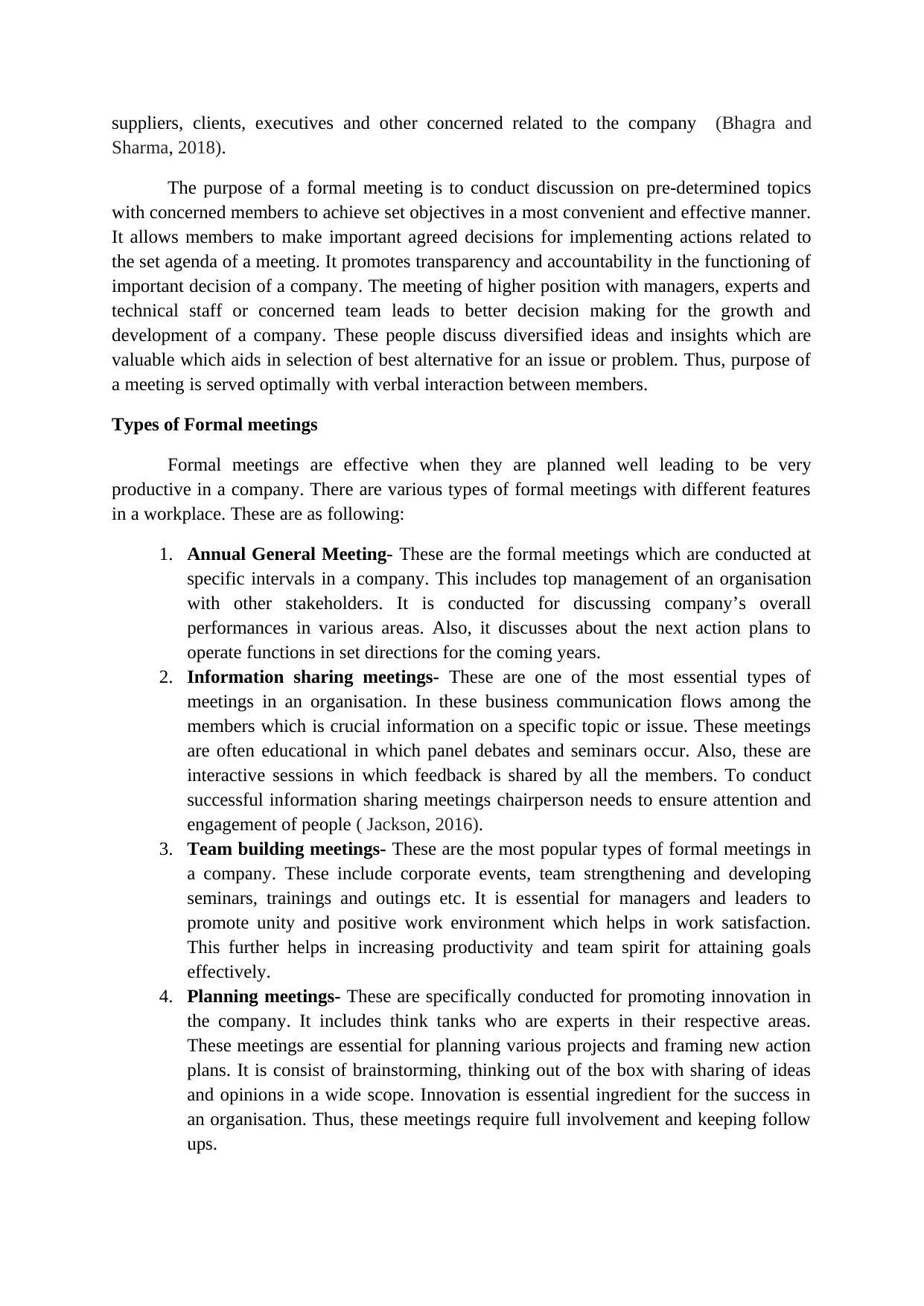
suppliers, clients, executives and other concerned related to the company (Bhagra and
Sharma, 2018).
The purpose of a formal meeting is to conduct discussion on pre-determined topics
with concerned members to achieve set objectives in a most convenient and effective manner.
It allows members to make important agreed decisions for implementing actions related to
the set agenda of a meeting. It promotes transparency and accountability in the functioning of
important decision of a company. The meeting of higher position with managers, experts and
technical staff or concerned team leads to better decision making for the growth and
development of a company. These people discuss diversified ideas and insights which are
valuable which aids in selection of best alternative for an issue or problem. Thus, purpose of
a meeting is served optimally with verbal interaction between members.
Types of Formal meetings
Formal meetings are effective when they are planned well leading to be very
productive in a company. There are various types of formal meetings with different features
in a workplace. These are as following:
1. Annual General Meeting- These are the formal meetings which are conducted at
specific intervals in a company. This includes top management of an organisation
with other stakeholders. It is conducted for discussing company’s overall
performances in various areas. Also, it discusses about the next action plans to
operate functions in set directions for the coming years.
2. Information sharing meetings- These are one of the most essential types of
meetings in an organisation. In these business communication flows among the
members which is crucial information on a specific topic or issue. These meetings
are often educational in which panel debates and seminars occur. Also, these are
interactive sessions in which feedback is shared by all the members. To conduct
successful information sharing meetings chairperson needs to ensure attention and
engagement of people ( Jackson, 2016).
3. Team building meetings- These are the most popular types of formal meetings in
a company. These include corporate events, team strengthening and developing
seminars, trainings and outings etc. It is essential for managers and leaders to
promote unity and positive work environment which helps in work satisfaction.
This further helps in increasing productivity and team spirit for attaining goals
effectively.
4. Planning meetings- These are specifically conducted for promoting innovation in
the company. It includes think tanks who are experts in their respective areas.
These meetings are essential for planning various projects and framing new action
plans. It is consist of brainstorming, thinking out of the box with sharing of ideas
and opinions in a wide scope. Innovation is essential ingredient for the success in
an organisation. Thus, these meetings require full involvement and keeping follow
ups.
Sharma, 2018).
The purpose of a formal meeting is to conduct discussion on pre-determined topics
with concerned members to achieve set objectives in a most convenient and effective manner.
It allows members to make important agreed decisions for implementing actions related to
the set agenda of a meeting. It promotes transparency and accountability in the functioning of
important decision of a company. The meeting of higher position with managers, experts and
technical staff or concerned team leads to better decision making for the growth and
development of a company. These people discuss diversified ideas and insights which are
valuable which aids in selection of best alternative for an issue or problem. Thus, purpose of
a meeting is served optimally with verbal interaction between members.
Types of Formal meetings
Formal meetings are effective when they are planned well leading to be very
productive in a company. There are various types of formal meetings with different features
in a workplace. These are as following:
1. Annual General Meeting- These are the formal meetings which are conducted at
specific intervals in a company. This includes top management of an organisation
with other stakeholders. It is conducted for discussing company’s overall
performances in various areas. Also, it discusses about the next action plans to
operate functions in set directions for the coming years.
2. Information sharing meetings- These are one of the most essential types of
meetings in an organisation. In these business communication flows among the
members which is crucial information on a specific topic or issue. These meetings
are often educational in which panel debates and seminars occur. Also, these are
interactive sessions in which feedback is shared by all the members. To conduct
successful information sharing meetings chairperson needs to ensure attention and
engagement of people ( Jackson, 2016).
3. Team building meetings- These are the most popular types of formal meetings in
a company. These include corporate events, team strengthening and developing
seminars, trainings and outings etc. It is essential for managers and leaders to
promote unity and positive work environment which helps in work satisfaction.
This further helps in increasing productivity and team spirit for attaining goals
effectively.
4. Planning meetings- These are specifically conducted for promoting innovation in
the company. It includes think tanks who are experts in their respective areas.
These meetings are essential for planning various projects and framing new action
plans. It is consist of brainstorming, thinking out of the box with sharing of ideas
and opinions in a wide scope. Innovation is essential ingredient for the success in
an organisation. Thus, these meetings require full involvement and keeping follow
ups.
Paraphrase This Document
Need a fresh take? Get an instant paraphrase of this document with our AI Paraphraser
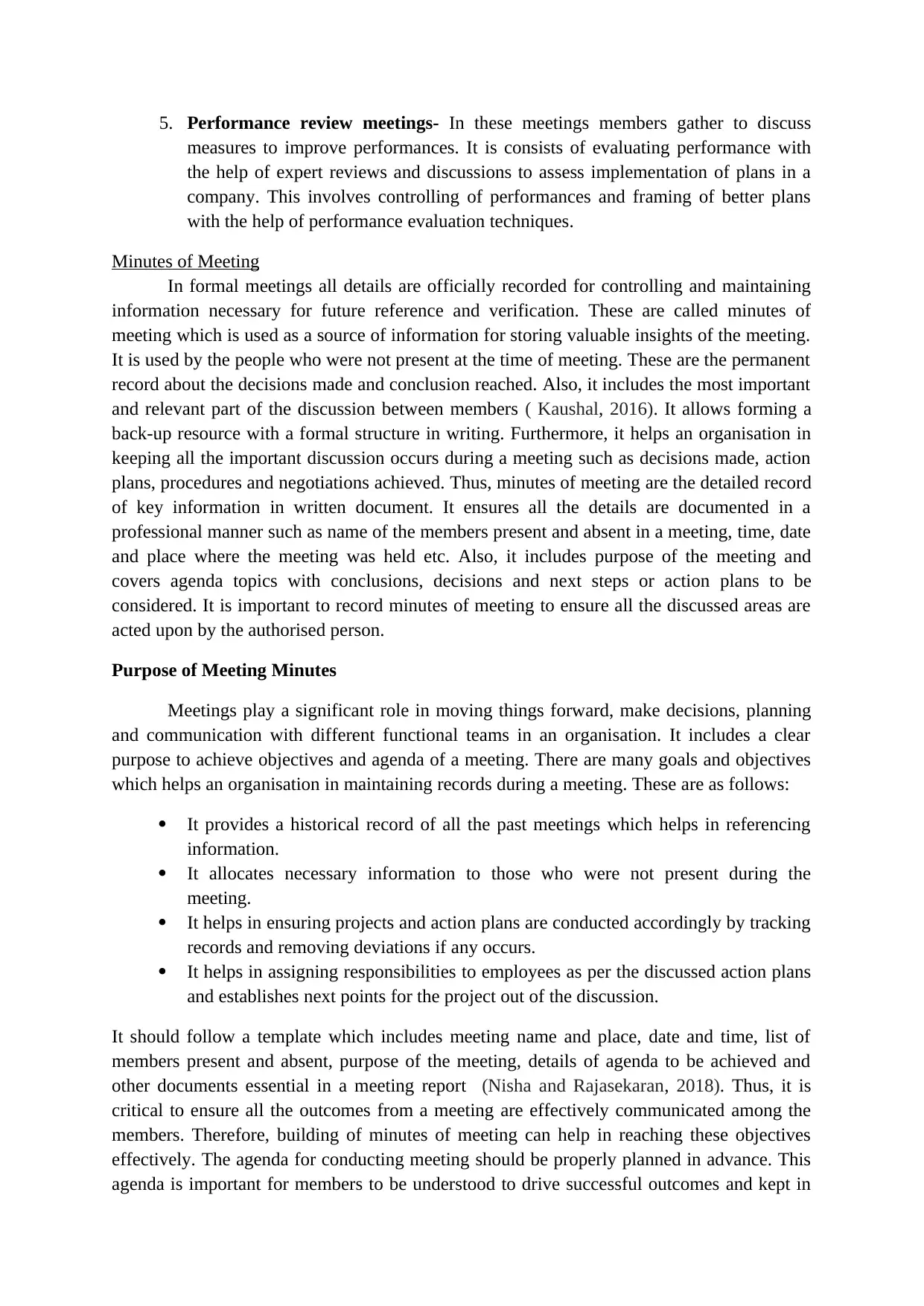
5. Performance review meetings- In these meetings members gather to discuss
measures to improve performances. It is consists of evaluating performance with
the help of expert reviews and discussions to assess implementation of plans in a
company. This involves controlling of performances and framing of better plans
with the help of performance evaluation techniques.
Minutes of Meeting
In formal meetings all details are officially recorded for controlling and maintaining
information necessary for future reference and verification. These are called minutes of
meeting which is used as a source of information for storing valuable insights of the meeting.
It is used by the people who were not present at the time of meeting. These are the permanent
record about the decisions made and conclusion reached. Also, it includes the most important
and relevant part of the discussion between members ( Kaushal, 2016). It allows forming a
back-up resource with a formal structure in writing. Furthermore, it helps an organisation in
keeping all the important discussion occurs during a meeting such as decisions made, action
plans, procedures and negotiations achieved. Thus, minutes of meeting are the detailed record
of key information in written document. It ensures all the details are documented in a
professional manner such as name of the members present and absent in a meeting, time, date
and place where the meeting was held etc. Also, it includes purpose of the meeting and
covers agenda topics with conclusions, decisions and next steps or action plans to be
considered. It is important to record minutes of meeting to ensure all the discussed areas are
acted upon by the authorised person.
Purpose of Meeting Minutes
Meetings play a significant role in moving things forward, make decisions, planning
and communication with different functional teams in an organisation. It includes a clear
purpose to achieve objectives and agenda of a meeting. There are many goals and objectives
which helps an organisation in maintaining records during a meeting. These are as follows:
It provides a historical record of all the past meetings which helps in referencing
information.
It allocates necessary information to those who were not present during the
meeting.
It helps in ensuring projects and action plans are conducted accordingly by tracking
records and removing deviations if any occurs.
It helps in assigning responsibilities to employees as per the discussed action plans
and establishes next points for the project out of the discussion.
It should follow a template which includes meeting name and place, date and time, list of
members present and absent, purpose of the meeting, details of agenda to be achieved and
other documents essential in a meeting report (Nisha and Rajasekaran, 2018). Thus, it is
critical to ensure all the outcomes from a meeting are effectively communicated among the
members. Therefore, building of minutes of meeting can help in reaching these objectives
effectively. The agenda for conducting meeting should be properly planned in advance. This
agenda is important for members to be understood to drive successful outcomes and kept in
measures to improve performances. It is consists of evaluating performance with
the help of expert reviews and discussions to assess implementation of plans in a
company. This involves controlling of performances and framing of better plans
with the help of performance evaluation techniques.
Minutes of Meeting
In formal meetings all details are officially recorded for controlling and maintaining
information necessary for future reference and verification. These are called minutes of
meeting which is used as a source of information for storing valuable insights of the meeting.
It is used by the people who were not present at the time of meeting. These are the permanent
record about the decisions made and conclusion reached. Also, it includes the most important
and relevant part of the discussion between members ( Kaushal, 2016). It allows forming a
back-up resource with a formal structure in writing. Furthermore, it helps an organisation in
keeping all the important discussion occurs during a meeting such as decisions made, action
plans, procedures and negotiations achieved. Thus, minutes of meeting are the detailed record
of key information in written document. It ensures all the details are documented in a
professional manner such as name of the members present and absent in a meeting, time, date
and place where the meeting was held etc. Also, it includes purpose of the meeting and
covers agenda topics with conclusions, decisions and next steps or action plans to be
considered. It is important to record minutes of meeting to ensure all the discussed areas are
acted upon by the authorised person.
Purpose of Meeting Minutes
Meetings play a significant role in moving things forward, make decisions, planning
and communication with different functional teams in an organisation. It includes a clear
purpose to achieve objectives and agenda of a meeting. There are many goals and objectives
which helps an organisation in maintaining records during a meeting. These are as follows:
It provides a historical record of all the past meetings which helps in referencing
information.
It allocates necessary information to those who were not present during the
meeting.
It helps in ensuring projects and action plans are conducted accordingly by tracking
records and removing deviations if any occurs.
It helps in assigning responsibilities to employees as per the discussed action plans
and establishes next points for the project out of the discussion.
It should follow a template which includes meeting name and place, date and time, list of
members present and absent, purpose of the meeting, details of agenda to be achieved and
other documents essential in a meeting report (Nisha and Rajasekaran, 2018). Thus, it is
critical to ensure all the outcomes from a meeting are effectively communicated among the
members. Therefore, building of minutes of meeting can help in reaching these objectives
effectively. The agenda for conducting meeting should be properly planned in advance. This
agenda is important for members to be understood to drive successful outcomes and kept in
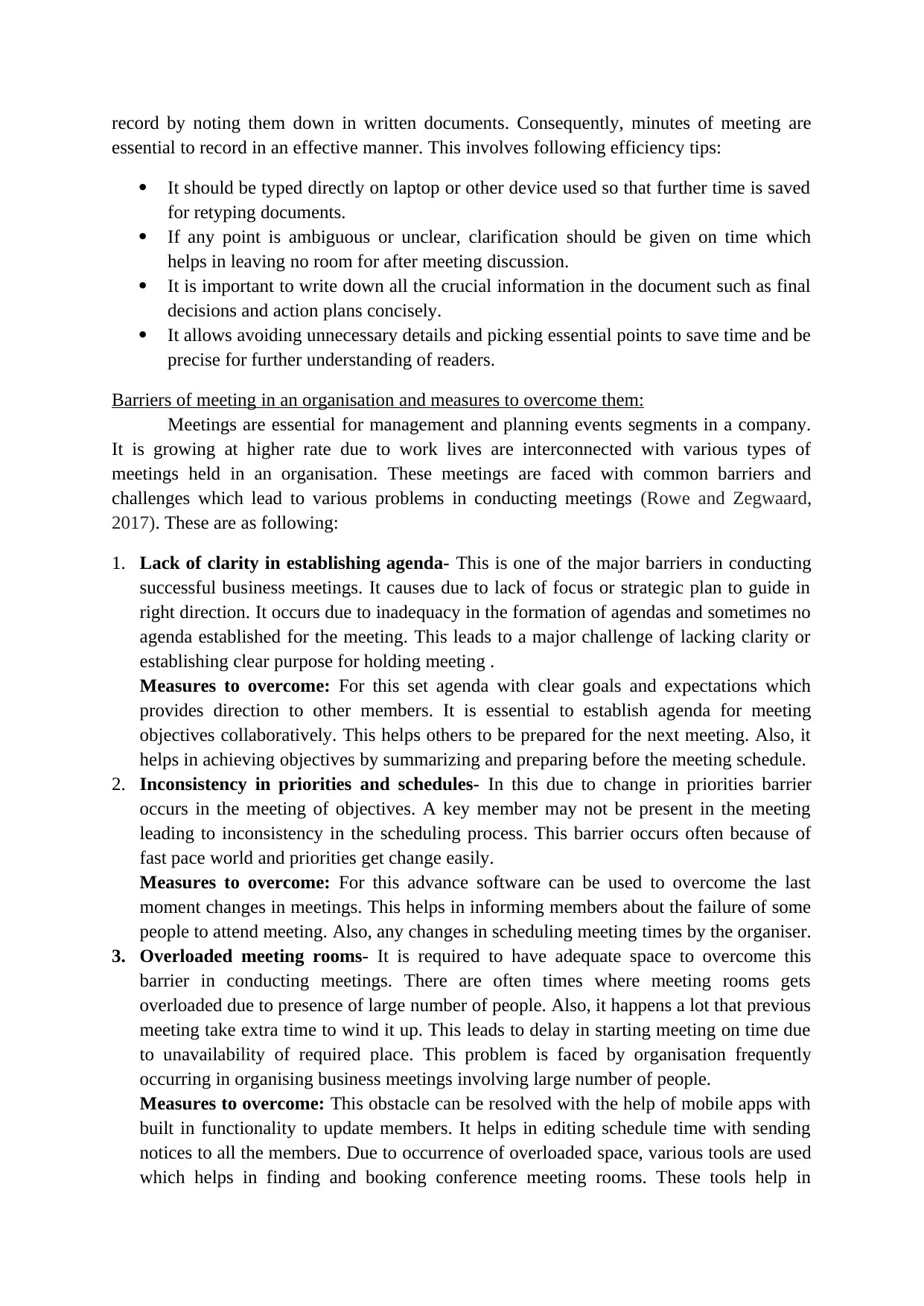
record by noting them down in written documents. Consequently, minutes of meeting are
essential to record in an effective manner. This involves following efficiency tips:
It should be typed directly on laptop or other device used so that further time is saved
for retyping documents.
If any point is ambiguous or unclear, clarification should be given on time which
helps in leaving no room for after meeting discussion.
It is important to write down all the crucial information in the document such as final
decisions and action plans concisely.
It allows avoiding unnecessary details and picking essential points to save time and be
precise for further understanding of readers.
Barriers of meeting in an organisation and measures to overcome them:
Meetings are essential for management and planning events segments in a company.
It is growing at higher rate due to work lives are interconnected with various types of
meetings held in an organisation. These meetings are faced with common barriers and
challenges which lead to various problems in conducting meetings (Rowe and Zegwaard,
2017). These are as following:
1. Lack of clarity in establishing agenda- This is one of the major barriers in conducting
successful business meetings. It causes due to lack of focus or strategic plan to guide in
right direction. It occurs due to inadequacy in the formation of agendas and sometimes no
agenda established for the meeting. This leads to a major challenge of lacking clarity or
establishing clear purpose for holding meeting .
Measures to overcome: For this set agenda with clear goals and expectations which
provides direction to other members. It is essential to establish agenda for meeting
objectives collaboratively. This helps others to be prepared for the next meeting. Also, it
helps in achieving objectives by summarizing and preparing before the meeting schedule.
2. Inconsistency in priorities and schedules- In this due to change in priorities barrier
occurs in the meeting of objectives. A key member may not be present in the meeting
leading to inconsistency in the scheduling process. This barrier occurs often because of
fast pace world and priorities get change easily.
Measures to overcome: For this advance software can be used to overcome the last
moment changes in meetings. This helps in informing members about the failure of some
people to attend meeting. Also, any changes in scheduling meeting times by the organiser.
3. Overloaded meeting rooms- It is required to have adequate space to overcome this
barrier in conducting meetings. There are often times where meeting rooms gets
overloaded due to presence of large number of people. Also, it happens a lot that previous
meeting take extra time to wind it up. This leads to delay in starting meeting on time due
to unavailability of required place. This problem is faced by organisation frequently
occurring in organising business meetings involving large number of people.
Measures to overcome: This obstacle can be resolved with the help of mobile apps with
built in functionality to update members. It helps in editing schedule time with sending
notices to all the members. Due to occurrence of overloaded space, various tools are used
which helps in finding and booking conference meeting rooms. These tools help in
essential to record in an effective manner. This involves following efficiency tips:
It should be typed directly on laptop or other device used so that further time is saved
for retyping documents.
If any point is ambiguous or unclear, clarification should be given on time which
helps in leaving no room for after meeting discussion.
It is important to write down all the crucial information in the document such as final
decisions and action plans concisely.
It allows avoiding unnecessary details and picking essential points to save time and be
precise for further understanding of readers.
Barriers of meeting in an organisation and measures to overcome them:
Meetings are essential for management and planning events segments in a company.
It is growing at higher rate due to work lives are interconnected with various types of
meetings held in an organisation. These meetings are faced with common barriers and
challenges which lead to various problems in conducting meetings (Rowe and Zegwaard,
2017). These are as following:
1. Lack of clarity in establishing agenda- This is one of the major barriers in conducting
successful business meetings. It causes due to lack of focus or strategic plan to guide in
right direction. It occurs due to inadequacy in the formation of agendas and sometimes no
agenda established for the meeting. This leads to a major challenge of lacking clarity or
establishing clear purpose for holding meeting .
Measures to overcome: For this set agenda with clear goals and expectations which
provides direction to other members. It is essential to establish agenda for meeting
objectives collaboratively. This helps others to be prepared for the next meeting. Also, it
helps in achieving objectives by summarizing and preparing before the meeting schedule.
2. Inconsistency in priorities and schedules- In this due to change in priorities barrier
occurs in the meeting of objectives. A key member may not be present in the meeting
leading to inconsistency in the scheduling process. This barrier occurs often because of
fast pace world and priorities get change easily.
Measures to overcome: For this advance software can be used to overcome the last
moment changes in meetings. This helps in informing members about the failure of some
people to attend meeting. Also, any changes in scheduling meeting times by the organiser.
3. Overloaded meeting rooms- It is required to have adequate space to overcome this
barrier in conducting meetings. There are often times where meeting rooms gets
overloaded due to presence of large number of people. Also, it happens a lot that previous
meeting take extra time to wind it up. This leads to delay in starting meeting on time due
to unavailability of required place. This problem is faced by organisation frequently
occurring in organising business meetings involving large number of people.
Measures to overcome: This obstacle can be resolved with the help of mobile apps with
built in functionality to update members. It helps in editing schedule time with sending
notices to all the members. Due to occurrence of overloaded space, various tools are used
which helps in finding and booking conference meeting rooms. These tools help in
⊘ This is a preview!⊘
Do you want full access?
Subscribe today to unlock all pages.

Trusted by 1+ million students worldwide
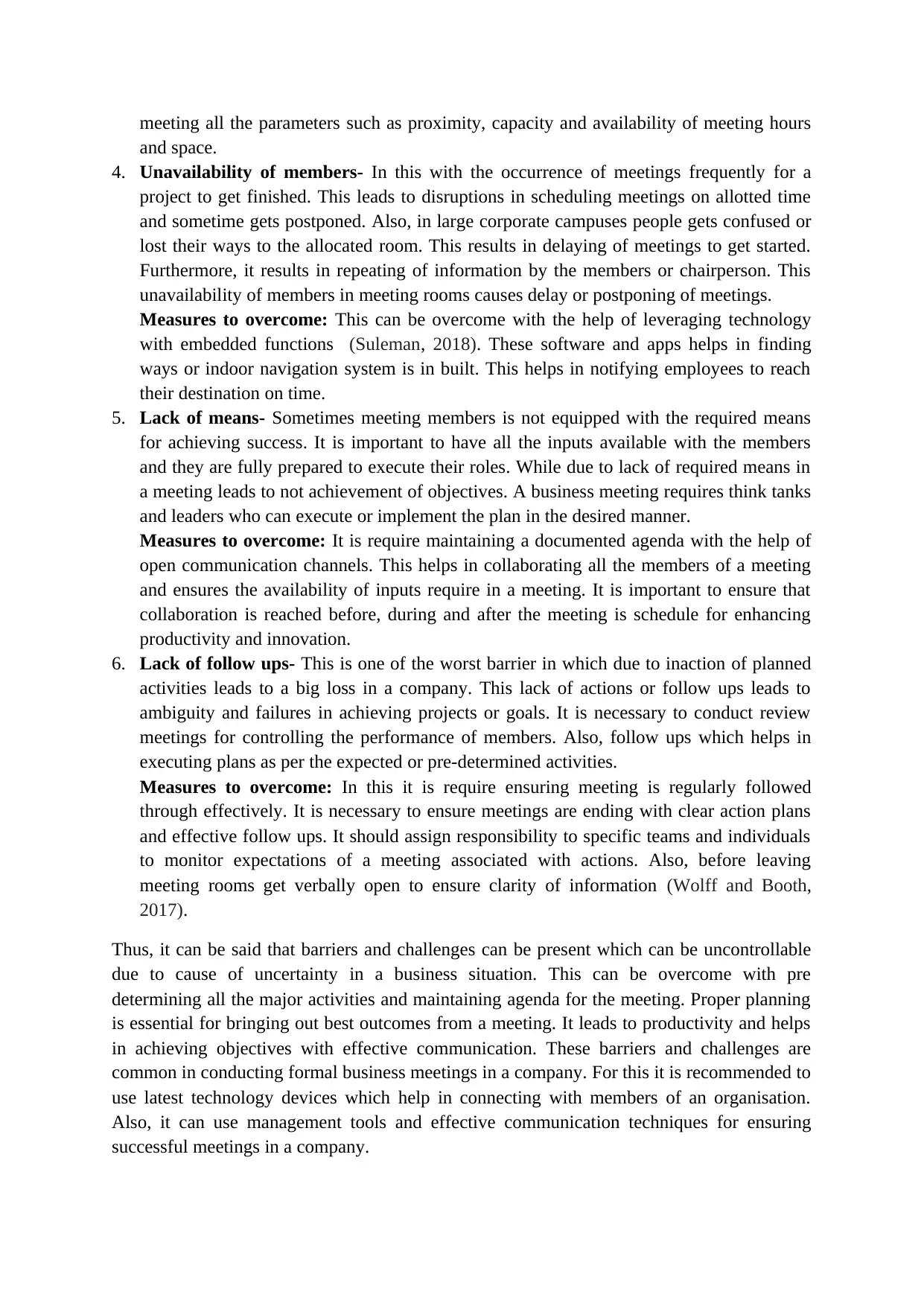
meeting all the parameters such as proximity, capacity and availability of meeting hours
and space.
4. Unavailability of members- In this with the occurrence of meetings frequently for a
project to get finished. This leads to disruptions in scheduling meetings on allotted time
and sometime gets postponed. Also, in large corporate campuses people gets confused or
lost their ways to the allocated room. This results in delaying of meetings to get started.
Furthermore, it results in repeating of information by the members or chairperson. This
unavailability of members in meeting rooms causes delay or postponing of meetings.
Measures to overcome: This can be overcome with the help of leveraging technology
with embedded functions (Suleman, 2018). These software and apps helps in finding
ways or indoor navigation system is in built. This helps in notifying employees to reach
their destination on time.
5. Lack of means- Sometimes meeting members is not equipped with the required means
for achieving success. It is important to have all the inputs available with the members
and they are fully prepared to execute their roles. While due to lack of required means in
a meeting leads to not achievement of objectives. A business meeting requires think tanks
and leaders who can execute or implement the plan in the desired manner.
Measures to overcome: It is require maintaining a documented agenda with the help of
open communication channels. This helps in collaborating all the members of a meeting
and ensures the availability of inputs require in a meeting. It is important to ensure that
collaboration is reached before, during and after the meeting is schedule for enhancing
productivity and innovation.
6. Lack of follow ups- This is one of the worst barrier in which due to inaction of planned
activities leads to a big loss in a company. This lack of actions or follow ups leads to
ambiguity and failures in achieving projects or goals. It is necessary to conduct review
meetings for controlling the performance of members. Also, follow ups which helps in
executing plans as per the expected or pre-determined activities.
Measures to overcome: In this it is require ensuring meeting is regularly followed
through effectively. It is necessary to ensure meetings are ending with clear action plans
and effective follow ups. It should assign responsibility to specific teams and individuals
to monitor expectations of a meeting associated with actions. Also, before leaving
meeting rooms get verbally open to ensure clarity of information (Wolff and Booth,
2017).
Thus, it can be said that barriers and challenges can be present which can be uncontrollable
due to cause of uncertainty in a business situation. This can be overcome with pre
determining all the major activities and maintaining agenda for the meeting. Proper planning
is essential for bringing out best outcomes from a meeting. It leads to productivity and helps
in achieving objectives with effective communication. These barriers and challenges are
common in conducting formal business meetings in a company. For this it is recommended to
use latest technology devices which help in connecting with members of an organisation.
Also, it can use management tools and effective communication techniques for ensuring
successful meetings in a company.
and space.
4. Unavailability of members- In this with the occurrence of meetings frequently for a
project to get finished. This leads to disruptions in scheduling meetings on allotted time
and sometime gets postponed. Also, in large corporate campuses people gets confused or
lost their ways to the allocated room. This results in delaying of meetings to get started.
Furthermore, it results in repeating of information by the members or chairperson. This
unavailability of members in meeting rooms causes delay or postponing of meetings.
Measures to overcome: This can be overcome with the help of leveraging technology
with embedded functions (Suleman, 2018). These software and apps helps in finding
ways or indoor navigation system is in built. This helps in notifying employees to reach
their destination on time.
5. Lack of means- Sometimes meeting members is not equipped with the required means
for achieving success. It is important to have all the inputs available with the members
and they are fully prepared to execute their roles. While due to lack of required means in
a meeting leads to not achievement of objectives. A business meeting requires think tanks
and leaders who can execute or implement the plan in the desired manner.
Measures to overcome: It is require maintaining a documented agenda with the help of
open communication channels. This helps in collaborating all the members of a meeting
and ensures the availability of inputs require in a meeting. It is important to ensure that
collaboration is reached before, during and after the meeting is schedule for enhancing
productivity and innovation.
6. Lack of follow ups- This is one of the worst barrier in which due to inaction of planned
activities leads to a big loss in a company. This lack of actions or follow ups leads to
ambiguity and failures in achieving projects or goals. It is necessary to conduct review
meetings for controlling the performance of members. Also, follow ups which helps in
executing plans as per the expected or pre-determined activities.
Measures to overcome: In this it is require ensuring meeting is regularly followed
through effectively. It is necessary to ensure meetings are ending with clear action plans
and effective follow ups. It should assign responsibility to specific teams and individuals
to monitor expectations of a meeting associated with actions. Also, before leaving
meeting rooms get verbally open to ensure clarity of information (Wolff and Booth,
2017).
Thus, it can be said that barriers and challenges can be present which can be uncontrollable
due to cause of uncertainty in a business situation. This can be overcome with pre
determining all the major activities and maintaining agenda for the meeting. Proper planning
is essential for bringing out best outcomes from a meeting. It leads to productivity and helps
in achieving objectives with effective communication. These barriers and challenges are
common in conducting formal business meetings in a company. For this it is recommended to
use latest technology devices which help in connecting with members of an organisation.
Also, it can use management tools and effective communication techniques for ensuring
successful meetings in a company.
Paraphrase This Document
Need a fresh take? Get an instant paraphrase of this document with our AI Paraphraser
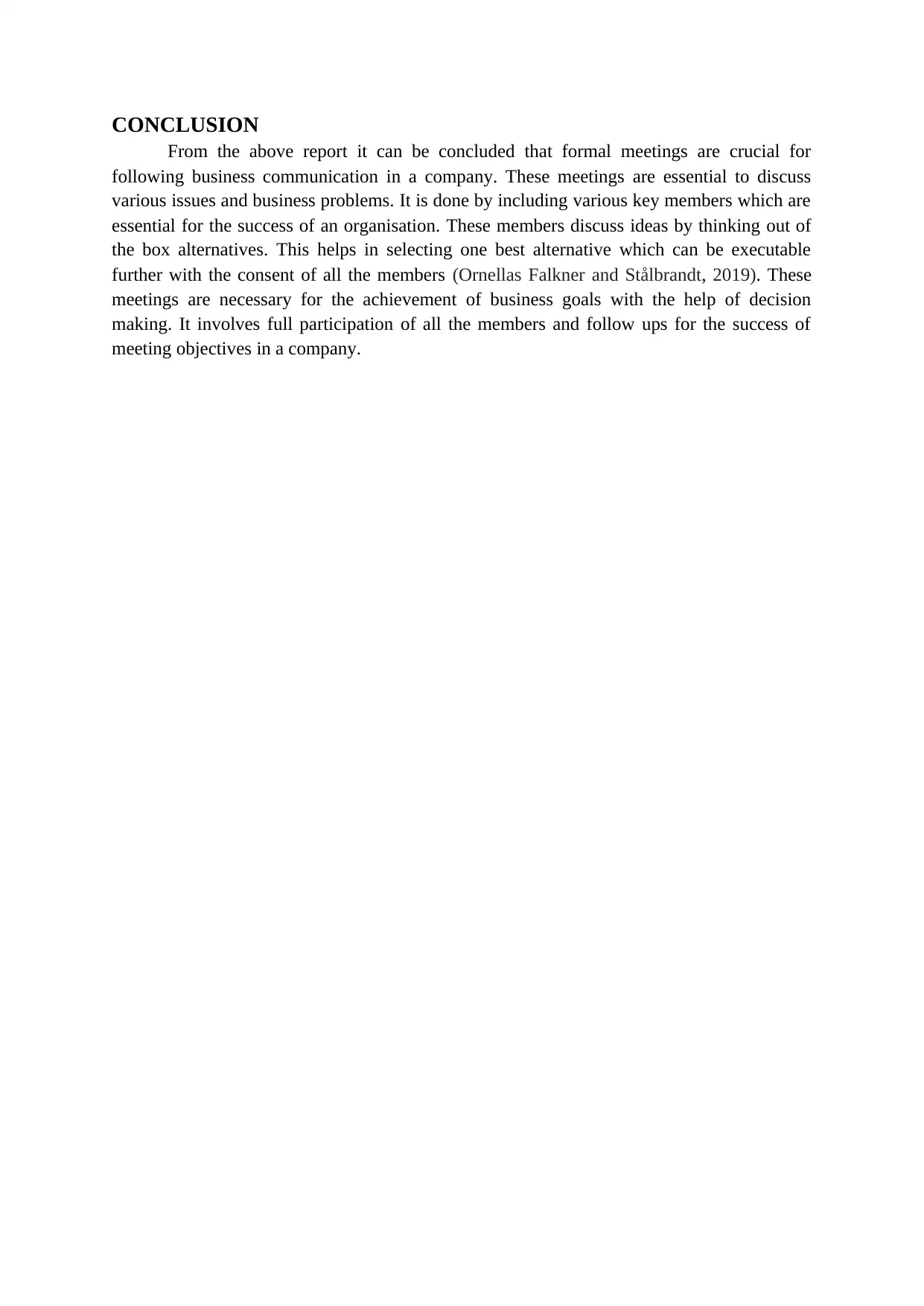
CONCLUSION
From the above report it can be concluded that formal meetings are crucial for
following business communication in a company. These meetings are essential to discuss
various issues and business problems. It is done by including various key members which are
essential for the success of an organisation. These members discuss ideas by thinking out of
the box alternatives. This helps in selecting one best alternative which can be executable
further with the consent of all the members (Ornellas Falkner and Stålbrandt, 2019). These
meetings are necessary for the achievement of business goals with the help of decision
making. It involves full participation of all the members and follow ups for the success of
meeting objectives in a company.
From the above report it can be concluded that formal meetings are crucial for
following business communication in a company. These meetings are essential to discuss
various issues and business problems. It is done by including various key members which are
essential for the success of an organisation. These members discuss ideas by thinking out of
the box alternatives. This helps in selecting one best alternative which can be executable
further with the consent of all the members (Ornellas Falkner and Stålbrandt, 2019). These
meetings are necessary for the achievement of business goals with the help of decision
making. It involves full participation of all the members and follow ups for the success of
meeting objectives in a company.

⊘ This is a preview!⊘
Do you want full access?
Subscribe today to unlock all pages.

Trusted by 1+ million students worldwide
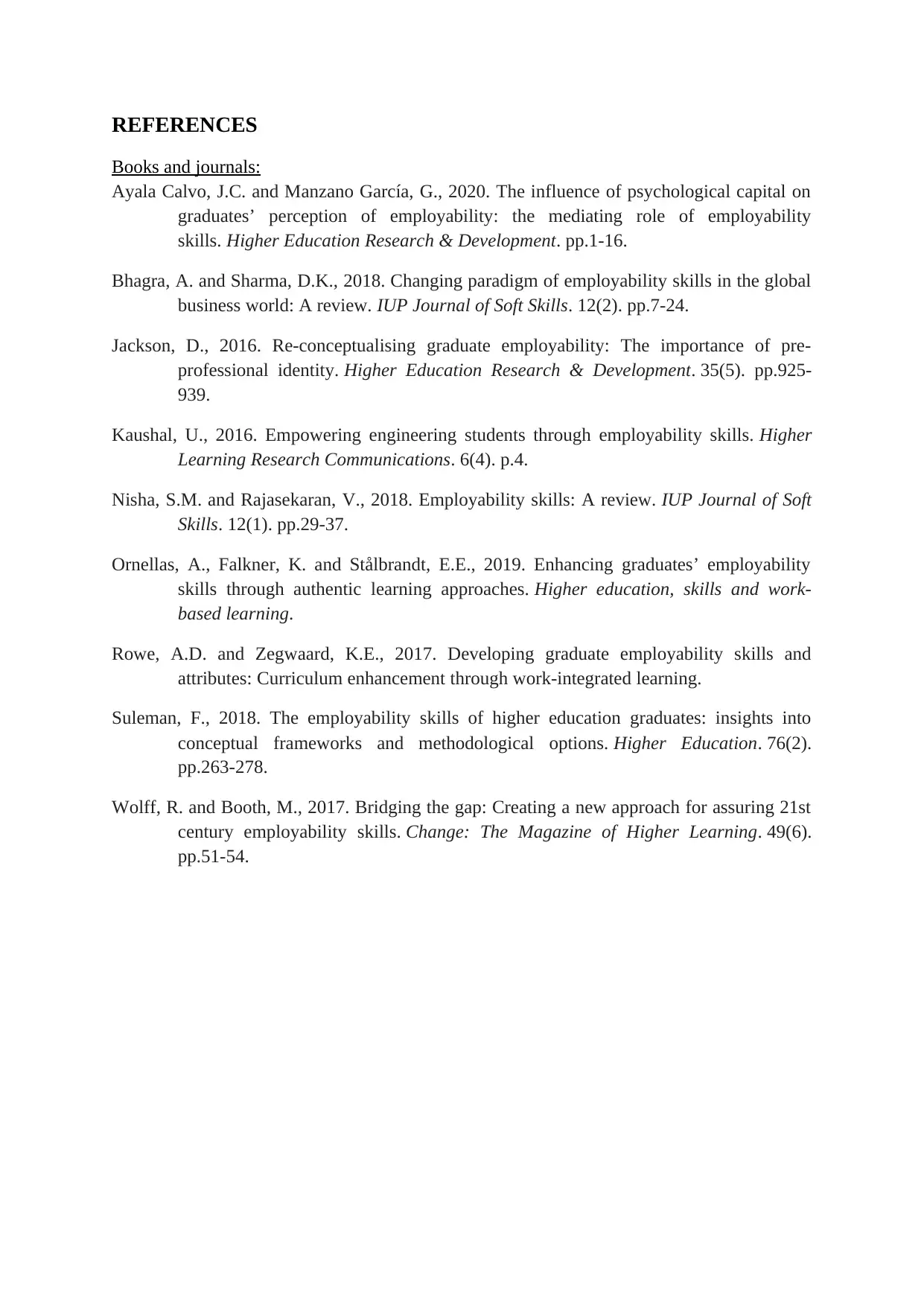
REFERENCES
Books and journals:
Ayala Calvo, J.C. and Manzano García, G., 2020. The influence of psychological capital on
graduates’ perception of employability: the mediating role of employability
skills. Higher Education Research & Development. pp.1-16.
Bhagra, A. and Sharma, D.K., 2018. Changing paradigm of employability skills in the global
business world: A review. IUP Journal of Soft Skills. 12(2). pp.7-24.
Jackson, D., 2016. Re-conceptualising graduate employability: The importance of pre-
professional identity. Higher Education Research & Development. 35(5). pp.925-
939.
Kaushal, U., 2016. Empowering engineering students through employability skills. Higher
Learning Research Communications. 6(4). p.4.
Nisha, S.M. and Rajasekaran, V., 2018. Employability skills: A review. IUP Journal of Soft
Skills. 12(1). pp.29-37.
Ornellas, A., Falkner, K. and Stålbrandt, E.E., 2019. Enhancing graduates’ employability
skills through authentic learning approaches. Higher education, skills and work-
based learning.
Rowe, A.D. and Zegwaard, K.E., 2017. Developing graduate employability skills and
attributes: Curriculum enhancement through work-integrated learning.
Suleman, F., 2018. The employability skills of higher education graduates: insights into
conceptual frameworks and methodological options. Higher Education. 76(2).
pp.263-278.
Wolff, R. and Booth, M., 2017. Bridging the gap: Creating a new approach for assuring 21st
century employability skills. Change: The Magazine of Higher Learning. 49(6).
pp.51-54.
Books and journals:
Ayala Calvo, J.C. and Manzano García, G., 2020. The influence of psychological capital on
graduates’ perception of employability: the mediating role of employability
skills. Higher Education Research & Development. pp.1-16.
Bhagra, A. and Sharma, D.K., 2018. Changing paradigm of employability skills in the global
business world: A review. IUP Journal of Soft Skills. 12(2). pp.7-24.
Jackson, D., 2016. Re-conceptualising graduate employability: The importance of pre-
professional identity. Higher Education Research & Development. 35(5). pp.925-
939.
Kaushal, U., 2016. Empowering engineering students through employability skills. Higher
Learning Research Communications. 6(4). p.4.
Nisha, S.M. and Rajasekaran, V., 2018. Employability skills: A review. IUP Journal of Soft
Skills. 12(1). pp.29-37.
Ornellas, A., Falkner, K. and Stålbrandt, E.E., 2019. Enhancing graduates’ employability
skills through authentic learning approaches. Higher education, skills and work-
based learning.
Rowe, A.D. and Zegwaard, K.E., 2017. Developing graduate employability skills and
attributes: Curriculum enhancement through work-integrated learning.
Suleman, F., 2018. The employability skills of higher education graduates: insights into
conceptual frameworks and methodological options. Higher Education. 76(2).
pp.263-278.
Wolff, R. and Booth, M., 2017. Bridging the gap: Creating a new approach for assuring 21st
century employability skills. Change: The Magazine of Higher Learning. 49(6).
pp.51-54.
Paraphrase This Document
Need a fresh take? Get an instant paraphrase of this document with our AI Paraphraser


⊘ This is a preview!⊘
Do you want full access?
Subscribe today to unlock all pages.

Trusted by 1+ million students worldwide
1 out of 12
Related Documents
Your All-in-One AI-Powered Toolkit for Academic Success.
+13062052269
info@desklib.com
Available 24*7 on WhatsApp / Email
![[object Object]](/_next/static/media/star-bottom.7253800d.svg)
Unlock your academic potential
Copyright © 2020–2025 A2Z Services. All Rights Reserved. Developed and managed by ZUCOL.





